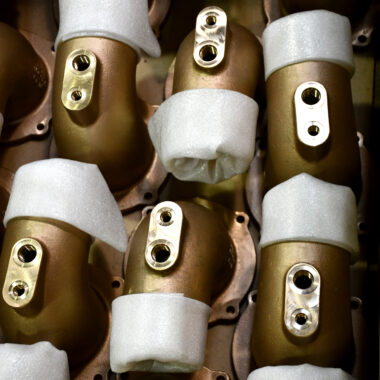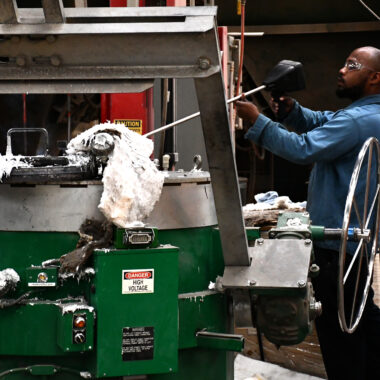About Aluminum Casting Fundamentals: Every Little Thing You Required to Know
About Aluminum Casting Fundamentals: Every Little Thing You Required to Know
Blog Article
Crafting Perfection: Just How to Achieve High-Quality Light Weight Aluminum Castings Every Time
In the world of light weight aluminum spreading, the search of perfection is a constant journey that needs a meticulous technique and an eager understanding of the details included. Attaining consistent premium light weight aluminum castings demands a detailed understanding of the processes, from selecting the proper alloy to implementing precise mold styles and thoroughly regulating spreading parameters.
Understanding Aluminum Casting Processes
Light weight aluminum casting procedures, crucial in the production industry, involve the intricate transformation of molten aluminum into solid forms through a series of carefully controlled steps. Understanding these processes is critical to accomplishing top notch light weight aluminum spreadings constantly - about aluminum casting. The main techniques utilized in aluminum casting are pass away spreading, sand spreading, and investment casting

Each of these procedures has its benefits and is picked based upon variables like intricacy, quantity, and wanted coating of the light weight aluminum spreading. about aluminum casting. Recognizing the details of these approaches is crucial for manufacturers aiming to produce top notch aluminum spreadings continually
Picking the Right Light Weight Aluminum Alloy
Selecting the appropriate light weight aluminum alloy is an essential choice in the production of high-quality light weight aluminum castings. The choice of alloy substantially affects the residential properties and qualities of the end product. Various aluminum alloys supply varying degrees of stamina, deterioration resistance, machinability, and thermal conductivity. When choosing an aluminum alloy for spreading, it is necessary to consider the certain requirements of the application to make certain optimal efficiency.
One of the most frequently made use of light weight aluminum alloys for spreading is A356 - about aluminum casting. For applications requiring high strength, 7075 aluminum alloy is a popular choice due to its extraordinary strength-to-weight ratio.
Along with mechanical residential properties, factors to consider such as price, schedule, and post-casting procedures must additionally influence the option of the appropriate light weight aluminum alloy. By meticulously reviewing these variables, suppliers can make certain the manufacturing of high-grade light weight aluminum spreadings that satisfy the preferred specs.
Executing Proper Mold And Mildew Layout
Developing an effective mold and mildew style is vital for making sure the successful production of high-quality light weight aluminum spreadings. Proper mold layout plays a considerable function in achieving the wanted attributes of the final product. To apply an effective mold and mildew design, factors such as product flow, cooling down prices, and part geometry must be carefully taken into consideration.
One key facet of mold layout is making sure correct filling and solidification of the light weight aluminum within the mold dental caries. This includes designing jogger and gating systems that help with smooth steel flow and prevent issues such as air Go Here entrapment or incomplete dental filling. Additionally, including cooling networks into the mold and mildew design assists regulate solidification rates and lower the risk of porosity or contraction defects.

Controlling Spreading Parameters

Ensuring Post-Casting High Quality Checks
To preserve the high top quality of light weight aluminum spreadings, extensive post-casting top quality checks are necessary. After the spreading procedure is completed, it is essential to make sure that the final items fulfill the desired standards and specs.
Dimensional accuracy is an additional essential aspect that must be verified during post-casting high quality checks. Measurements of crucial measurements and resistances must be required to verify that the spreadings comply with the called for specs. Furthermore, mechanical buildings such as solidity, tensile toughness, and influence resistance might require to be examined with material testing to ensure that the castings have the essential toughness and longevity for their desired application.
Final Thought
To conclude, accomplishing premium aluminum spreadings calls for a detailed understanding of the spreading processes, selecting the appropriate alloy, making mold and mildews successfully, controlling spreading criteria thoroughly, and conducting post-casting top quality checks faithfully. By complying with these steps, suppliers can constantly produce light weight aluminum castings that meet the highest possible requirements of quality and efficiency.
Accomplishing consistent high-grade aluminum spreadings demands a comprehensive understanding of the processes, from picking the suitable alloy to executing exact mold layouts and carefully regulating casting criteria. The primary approaches used in light weight aluminum spreading are die spreading, sand casting, and financial investment spreading.
Investment spreading, additionally known as accuracy spreading, involves developing wax patterns that are coated in ceramic to create molds.Choosing the proper light weight aluminum alloy is a crucial choice in the manufacturing of top notch light weight aluminum spreadings.Ensuring specific control over casting specifications is important for preserving uniformity and quality in light weight aluminum spreading production.
Report this page